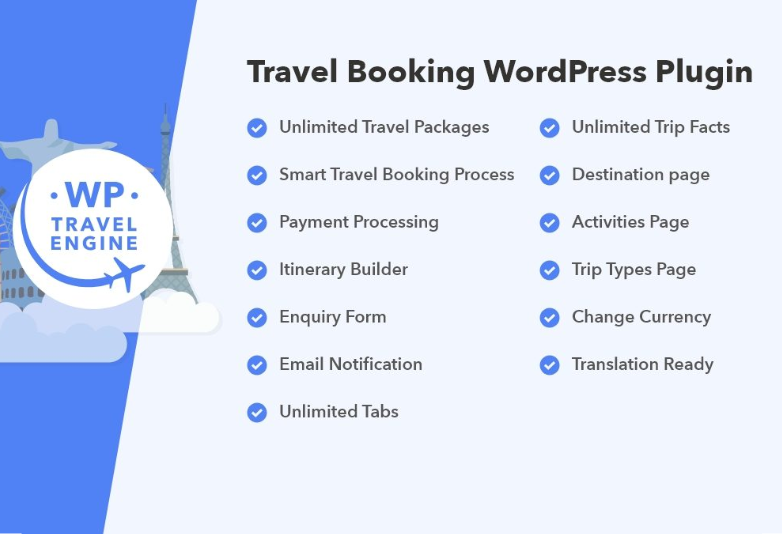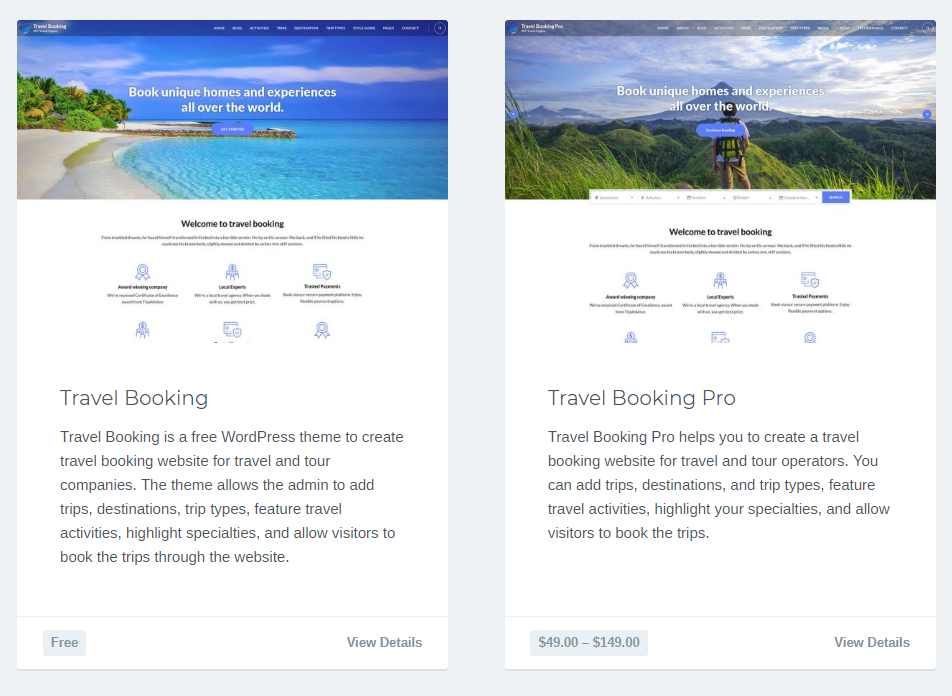
Complete Guide of How to Make a Travel Booking Website
The laurels of Booking.com or Airbnb inspire a lot of other business-minded people to build a travel booking website. The global tourism industry is flourishing year over year. So why not generate some revenue from the human wish to see the world? And though developing a travel website might be a challenge, there are several options for an aspiring entrepreneur. And in this article, we will review the features and tools required for a successful launch of such a project and answer how to build a travel booking website.
Tourism is a lucrative segment from all points of view. As a human, you probably enjoy trips and sightseeing. As a digital entrepreneur, you might have had a thought about creating your own travel booking website. And you are not wrong with that kind of a business idea.
Digital travels sales in the United States were predicted to reach 115.27 billion U.S. dollars in 2020, dropping 44.7 percent over 2019's sales figure of 208.44 billion U.S. dollars. This drop was stated by the source as a result of the coronavirus (COVID-19) pandemic. Digital travel sales were forecast to reach 220.87 billion U.S. dollars by 2024.

According to a study conducted in the fourth quarter of 2021, computers were the most popular channel for travelers worldwide to plan and book their next vacation. Overall, more than half of surveyed global consumers of all ages said they use desktop PCs for such purposes. Talking face-to-face with a travel agent was the second most popular way to organize a vacation, chosen by about two in ten respondents of all ages.

STEP 1: CHOOSE YOUR REVENUE MODEL AND NICHE FOR BOOKING WEBSITE
What are you going to offer: hotel bookings, flight bookings, cruises or maybe travel packages at once? Each of those segments requires a different approach to sourcing information and website development methods. The decision is up to you, but if the complexity of the technical part is of priority, consider discussing the options with your developers or an agency first. It will save you lots of effort and money in the long run.
The first point to consider is your future sources of revenue. The primary one is the transactions fee — the money you get every time somebody makes a purchase on your website. Referrals are also a major source of income. This works if you have special price agreements with the hotels, airlines or other tourism service providers. Advertising can also bring you additional revenue through CPA (cost per action) affiliate networks. But you have to make sure that the ads are connected with the tourism topic. And note that it won’t work for every kind of travel booking website.
Another thing you should choose is your target audience segment and one way of dividing it is into mass-market (vacation booking with hot sale travel packages, booking websites for any budget) and luxury (expensive apartments, villas, boutique hotel booking websites). It might not be obvious from the start but both options can influence the technical part of the project.
A mass-market travel site should be able to handle multiple user inquiries and seasonal fluctuations. So you might have to pay additional attention to the server part of the project. Also, the process of payment collection should be smooth and comfortable. Some travel booking decisions are quite spontaneous. And if your site is unable to receive immediate payments upon customer’s decision, you might lose profit.
Working with luxury segments requires a different approach. For example, with that type of clients, you might not be able to generate additional revenue from advertising. They won’t tolerate it and switch to another travel site right away. Such clients also have more expectations for content quality. So making sure your pages with high-resolution pictures load fast on any gadget would be more valuable for your business.
And if you are considering the luxury segment, keep in mind that such clients usually have a personal travel agent, who might have worked years with them. So if you want to create a luxury travel site, you might need to invent some really convenient feature to substitute a trusted human partner.
STEP 2: PICK THE FEATURES FOR CREATING A BOOKING WEBSITE
Travel booking portal requires a lot of attention in terms of functionality. There are various options depending on the purpose. But some of the features are almost a must-have for any travel project.
Listings management
With the thousands of offers changing in real-time mode, a travel booking website requires an algorithm to manage all the inquiries. This includes tracking if the option is still available, if the price is pertinent, etc. From the technical point of view, this might imply working with API or web crawling services.
Currency converter
This plugin makes your international clients feel much more comfortable. If they know what amount of their currency they actually have to pay, the decision to make a purchase comes way easier.
Payment collection
If users can make purchases straight through your website, you need to foresee incorporating several payment methods (e.g., Visa, Mastercard, Paypal, Skill, etc.). Some might work better than the others for various clients.
Booking confirmation
There are various booking plugins for this feature, but sometimes they fail to actually connect with the service provider. So, you may want to test the options first and see what works best. Or develop your own customized solution.
Map integration
Though the regular Google maps are right at hand, it’s still way easier to click on the same web site than to go somewhere else. Re-shifting attention of the client to check where the place to travel actually is may rob you of the deal. Foresee your own map integration to keep the customer involved as long as possible.
Price tracker
Some travel booking decisions are very spontaneous. And they mostly come from a good sale of tourism companies. So, add a price tracker to your project and you will be able to offer the lowest prices and discounts in real-time mode.
Trip planner
This plugin (or a separately developed feature) helps your clients to construct complicated routes. Once they get involved in the process on your web site, the possibility of making the purchase rises manifold.
Filters
Help your customers quickly find what they are searching for. Install various filters to easy the choice making.
And there are additional options like the weather forecast, client reviews, rankings, videos, etc. You might not need all the features you could think of for an MVP. Choose the basics to start with.
While prototyping, see to it that your navigation is easy to use. And that the technology you use is good for rich media, high traffic load, etc. If unsure what is the necessary minimum for your project, a piece of professional advice from an experienced tech partner is very beneficial.
STEP 3: DISCOVER DEVELOPMENT OPTIONS FOR CREATING A TRAVEL WEBSITE
On the one hand, you can start a travel booking website with ready-made templates in a CMS like Wordpress. On the other, you can build a booking platform from scratch and delegate the project to a development agency. Let’s dive into details with each option.
Build it based on ready-made solutions
How to make a travel booking website using Wordpress? It might surprise you, but there are Wordpress plug-ins and templates dedicated fully to travel booking websites. So one of the options is to make use of what already exists. It might work even faster if you have basic knowledge of the Wordpress functionality, coding, and online advertisement settings. You will have to buy a domain name and hosting, integrate the necessary API or a web crawling service, and employ basic SEO for a better search position.
Web scraping services might be handy for obtaining all the necessary data about booking availability, dates, flight and so on. They aggregate information using meta search engines. Such products like PromptCloud, Alexscraping or similar may be helpful.

There are several packages of features and themes from Wordpress. You can choose free or paid options for the basic prototype.

And if your creative approach goes further, you might take some add-ons from the available list. You can provide your customers with various payment options, offer them an internal search engine or maybe remind your future tourists about the forthcoming trip!

CREATE A TRAVEL WEBSITE FROM SCRATCH
The other development option is to build your own travel website from scratch. Here’s where you have the full freedom to create exactly what you want. The web site developed solely for your business goals will be unique on the overloaded market. It will make you stand out from the start. A great advantage.
Another advantage is that creating a website from scratch allows for more sophisticated features and backend coding, such as a custom made payment system.
Moreover, the clean code is more secure and flexible, especially given that travel booking requires so many features at once. Usually, experienced tech companies already know what the major challenges for travel booking projects are. They can advise you on how to create a travel website and make the best decision about features, functioning, or add-ons.
Who can assist with travel website design and development
If you have all the knowledge required for successful Wordpress project launch, you can try to do the whole thing yourself. As an alternative, you may hire a freelancer to help you or to do the entire coding job. Though it is cheaper, in both cases you or the other specialist should possess the required skills in travel booking website development.
An alternative and more safe option is to work with a web development agency. Surely, this is going to cost more than a freelancer. But instead, you will receive a high-quality product tailored to your needs and the project’s vision. In this case, you are not limited to templates and you can have virtually any kind of functionality that you see fit on a travel website.
CREATE A TRAVEL BOOKING WEBSITE WITH AN OUTSOURCING PARTNER: COST
Below in the table we present the average prices for the development of sites of varying complexity by region of the world.
| Simple website | Medium Website | Large Custom Website | |
| USA | $2k–$25k | $26k–$52k | $53k–$1mln+ |
| Europe | $1k–$6,5k | $9,5k–$20k | $25k–$1mln+ |
| Asia | $500–$3k | $4k–$8k | $10k–1mln+ |
| Australia | $2k–$23k | $20k–$47k | $48k–$1mln+ |
You can also estimate the cost of developing a project with Gearheart by reviewing the rates of our specialists and using the calculator. As well as ask us additional questions on how to make a travel booking website avoiding unnecessary costs.
Read also How to build a website like airbnb
WRAP UP
We have given short information on how to build a travel website and an overview of various approaches. You can now evaluate the pros and cons of each and make the choice. Whether you will handle the development yourself, hire a freelancer or a web dev agency, it’s never too late to ask for professional advice on MVP, functions, features or the sales funnel of your project. Also you can read more about web app development services.
Consider Gearheart Your Trusted Partner
To get to know us better, read about our processes and how we work, as well as about everything you need to do before outsourcing a project. You may also be interested in our portfolio, which features websites, as well as other platforms and apps of varying complexity from different business areas. We'd love to discuss your ideas and help you develop the perfect product. Just write to us.
FAQ
- What is a scalable web application?
Scalability is the ability of your web application to cope with the growing number of users interacting with the application at the same time. - What does scalable web app mean?
A scalable web application is an application that works equally well with one or a thousand users and can handle traffic spikes and drops. - What makes a website scalable?
Many elements can affect scalability, including web architecture, suitable framework, carefully chosen hardware, third-party services, and others. - How would you design scalable applications?
Follow these principles:
- Scale horizontally
- API first
- Cache everything
- Distribute work away from the core
- Choose asynchronism
- Design for maintenance and process automation
- Aim for statelessness

